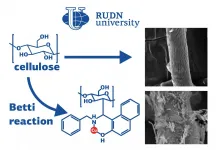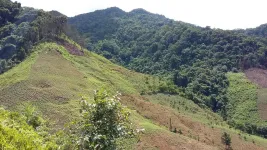Getting to the bottom of all life: Visualizing a protein key to enabling
Scientists reveal the exact process behind the upkeep of one of the cellular components where
2021-07-12
(Press-News.org) "All living beings, including us, depend on photosynthesis," says Prof. Wataru Sakamoto of the Institute of Plant Science and Resources at Okayama University, Japan, as he begins to explain the core concepts behind a recent breakthrough in understanding plant physiology, which he was involved in. "Photosynthesis produces the energy needed to sustain plants and the oxygen we breathe. This reaction occurs in two steps, the first of which involves capturing light energy
and producing oxygen. This step takes place in a cell organelle in the plant cells called the chloroplast: specifically, in the membranes of one of its components, the thylakoid. The thylakoid membrane is unique to oxygen?producing organisms like plants and cyanobacteria,
and its role has been known for over 200 years. Yet, even today in the technology age, the precise mechanisms that that shape this structure are unknown to us."
Now, Prof. Sakamoto and an international team of scientists have answered part of this question by focusing on a membrane remodeling protein, called VIPP1, which has been found to be involved in maintaining the integrity of the thylakoid membrane. Using high resolution imaging via cryo?electron microscopy, they've elucidated the mechanism by which this protein protects thylakoid membrane integrity. Their findings are published in the journal Cell.
Speaking of his motivation for being part of this study, Prof. Sakamoto says, "Chloroplasts in land plants are thought to have been derived from the endosymbiosis of cyanobacteria in plants 1.5 billion years ago. I was very fascinated by this during my college years and decided to study such organelles containing multiple membranes and their own DNA, like mitochondria and chloroplasts. In my laboratory, I have been working on VIPP1 since 2006, and have reported several of its important characteristics."
In this study, what the scientists observed was remarkable. Three VIPP1 monomers 'flex and interweave' in a specific formation to create a nucleotide binding pocket. Nucleotide binding to specific layers of such interwoven monomers cause layer stacking that results in basketlike structures of different symmetries. A part of the monomer is an amphiphilic--structure containing both water?attracting and water?repelling portions--helix. Within the basket
structure, these helices are oriented such that their hydrophilic (water?attracting) portions face the outside of the basket and their hydrophobic (water?repelling) portions face the inside of the basket. The hydrophobic portions are also lipid (fat) attracting. Thylakoid membranes, like most cell membranes, are lipid membranes. The hydrophobic interior of the basket structure binds to the membrane and remodels it by increasing its curvature.
In their experiments, when the scientists added mutations to prevent the hydrophobic surfaces from forming, stress on the membrane from high intensity light caused the thylakoid membrane to swell up and get damaged. This damage did not occur in membranes which had access to VIPP1 oligomers with hydrophobic surfaces.
Dr. Sakamoto explains the importance of these results in the field of research: "Our study reports that the membrane?remodeling protein VIPP1 plays a critical role in maintaining thylakoid membranes. This protein appears to share a common structure with ESCRT?III, which
is important in membrane remodeling in humans and yeast, indicating that the mechanism at play here is a common mechanism regulating membrane integrity." Further referring to more tangible potential practical applications, he says: "Thylakoid is key to photosynthesis. Understanding its structure in detail can help crop production and thus food security. For instance, improving thylakoid membrane longevity can improve crop productivity." And of course, all things considered, this finding resolves a long?standing mystery in the biology underlying photosynthesis.
INFORMATION:
[Attachments] See images for this press release:

ELSE PRESS RELEASES FROM THIS DATE:
2021-07-12
RUDN and Shahid Beheshti University (SBU) chemist proposed a protocol for converting cellulose into a catalyst for the synthesis of oxadiazoles. The new approach makes the catalyst 3 times more stable compared to the same catalyst obtained by the traditional method. The results are published in Carbohydrate Polymers
One of the directions of green chemistry is the biopolymers functionalization. Chemists modify polymers obtained from plants and animals -- they add functional molecular groups to them to get useful substances. For example, the catalysts for oxadiazoles synthesis are created from cellulose. They are necessary to produce polymers, dyes, medicines, and photographic ...
2021-07-12
Tel Aviv University's new and groundbreaking technology inspires hope among people who have lost their sense of touch in the nerves of a limb following amputation or injury. The technology involves a tiny sensor that is implanted in the nerve of the injured limb, for example in the finger, and is connected directly to a healthy nerve. Each time the limb touches an object, the sensor is activated and conducts an electric current to the functioning nerve, which recreates the feeling of touch. The researchers emphasize that this is a tested and safe technology that is suited to the human body and could be implanted anywhere inside of it once clinical trials will be done.
The technology was developed under the leadership of a team of experts from Tel Aviv University: Dr. Ben M. Maoz, ...
2021-07-12
For quite some time, farmers and researchers have been focusing on how to bind carbon to soil. Doing so makes food crops more nutritious and increases yields.
However, because carbon is converted into CO2 when it enters the atmosphere, there is a significant climate benefit to capturing carbon in soil as well.
Too much carbon finds its way into the atmosphere. Should we fail to reverse this unfortunate trend, we will fail to achieve the Paris Agreement's goal of reducing greenhouse gas emissions by 40 percent by 2030, according to CONCITO, Denmark's Green Think Tank.
As such, it is important to find new ways of sequestering carbon in soil. This ...
2021-07-12
A Moon-scanning method that can automatically classify important lunar features from telescope images could significantly improve the efficiency of selecting sites for exploration.
There is more than meets the eye to picking a landing or exploration site on the Moon. The visible area of the lunar surface is larger than Russia and is pockmarked by thousands of craters and crisscrossed by canyon-like rilles. The choice of future landing and exploration sites may come down to the most promising prospective locations for construction, minerals or potential energy resources. However, scanning by eye across such a large area, looking for features perhaps a few hundred meters across, is laborious and often inaccurate, which makes it difficult ...
2021-07-12
Smoking among young teens has become an increasingly challenging and costly public healthcare issue. Despite legislation to prevent the marketing of tobacco products to children, tobacco companies have shrewdly adapted their advertising tactics to circumvent the ban and maintain their access to this impressionable--and growing--market share.
How they do it is the subject of a recent study led by Dr. Yael Bar-Zeev at Hebrew University of Jerusalem (HU)'s Braun School of Public Health and Community Medicine at HU-Hadassah Medical Center. She also serves as Chair ...
2021-07-12
Forest clearance in Southeast Asia is accelerating, leading to unprecedented increases in carbon emissions, according to new research.
The findings, revealed by a research team including University of Leeds academics, show that forests are being cut down at increasingly higher altitudes and on steeper slopes in order to make way for agricultural intensification.
As a result, more than 400 million metric tons of carbon are released into the atmosphere every year as forests are cleared in the region, with that emissions figure increasing in recent ...
2021-07-12
A Sussex team - including university mathematicians - have created a new modelling toolkit which predicts the impact of COVID-19 at a local level with unprecedented accuracy. The details are published in the International Journal of Epidemiology, and are available for other local authorities to use online, just as the UK looks as though it may head into another wave of infections.
The study used the local Sussex hospital and healthcare daily COVID-19 situation reports, including admissions, discharges, bed occupancy and deaths.
Through the pandemic, the newly-published modelling has been used by local NHS and public ...
2021-07-12
Humans can easily identify sweet-tasting foods - and with pleasure. However, many carnivorous animals lack this ability, and whether birds, descendants of meat-eating dinosaurs, can taste sweet was previously unclear. An international team of researchers led by Max Planck Institute for Ornithology including Dr Simon SIN from Research Division for Ecology and Biodiversity, The University of Hong Kong (HKU), has now shown that songbirds, a group containing over 4,000 species, can sense sweetness regardless of their primary diets. The study highlights a specific event in the songbird ancestors ...
2021-07-12
In the vicinity of black holes, space is so warped that even light rays may curve around them several times. This phenomenon may enable us to see multiple versions of the same thing. While this has been known for decades, only now do we have an exact, mathematical expression, thanks to Albert Sneppen, student at the Niels Bohr Institute. The result, which even is more useful in realistic black holes, has just been published in the journal Scientific Reports.
You have probably heard of black holes -- the marvelous lumps of gravity from which not even light can escape. You may also have heard that space itself and even time behave oddly near black holes; space is warped.
In the vicinity of a black hole, space ...
2021-07-12
The impact of El Nino on East Asian climate under a warmer climate will be dominated by the change in El Nino decaying pace, according to a new paper published by a research team based in the Institute of Atmospheric Physics, Chinese Academy of Sciences, China.
The western North Pacific anomalous anticyclone (WNPAC) is a low-level atmospheric circulation system, linking up El Nino events with East Asian -western Pacific summer climate. The WNPAC can persist from El Nino mature phase in boreal winter to the upcoming summer, bringing abundant moisture to enhance the precipitation over East Asia. How the WNPAC will change in the future concerns millions of ...
LAST 30 PRESS RELEASES:
[Press-News.org] Getting to the bottom of all life: Visualizing a protein key to enabling
Scientists reveal the exact process behind the upkeep of one of the cellular components where








